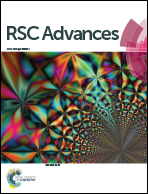Multifunctional gadolinium-labeled silica-coated core/shell quantum dots for magnetic resonance and fluorescence imaging of cancer cells†
Abstract
A new magnetic resonance (MR)/optical nanoparticle based on silica-coated CuInS2/ZnS nanoparticles with covalent attachment of a Gd3+ complex for cancer cell imaging is reported. We introduce silica to interdigitate with hydrophobic, protective agents on the surface of CuInS2/ZnS nanoparticles that allows phase transfer of hydrophobic nanoparticles from the organic into the aqueous phase. Carbodiimide chemistry is used to covalently couple the Gd3+-complex on the surface of silica-coated CuInS2/ZnS nanoparticles for magnetic resonance and fluorescence imaging of cancer cells. The longitudinal relaxivity value is 8.45 mM−1 s−1 for the dual-modality nanoparticles on the 3.0 T scanner, suggesting the possibility of using the nanoparticles as a T1 contrast agent. The dual-modality nanoparticles exhibit negligible cytotoxicity with >80% cell viability in human pancreatic cancer cell line BXPC-3 cells after 24 h. The nanoparticles with both optical and MR imaging in the aqueous solution were applied to cells in culture. These results show that the quantum yield and gadolinium concentration in the nanoparticles are sufficient to produce contrast for both modalities at relatively low concentrations of nanoparticles.


 Please wait while we load your content...
Please wait while we load your content...